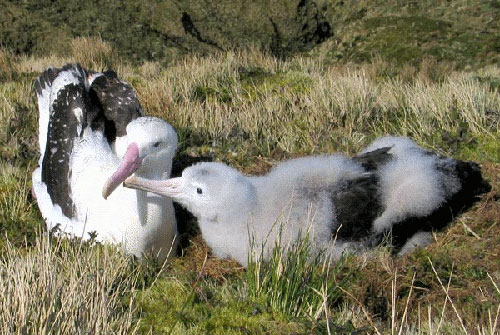Tristan da Cunha (part of the United Kingdom Overseas Territory of St Helena, Ascension and Tristan da Cunha) in the South Atlantic has adopted an implementation plan for the Agreement on the Conservation of Albatrosses and Petrels (ACAP). The plan has been produced by Dr Anton Wolfaardt, ACAP coordinator for UK South Atlantic Overseas Territories based at the UK's Joint Nature Conservation Committee (www.jncc.gov.uk), along with James Glass and Trevor Glass, respectively heads of the Tristan Departments of Fisheries and of Conservation.
The 46-page report (click here) reviews current work and sets out a prioritised work programme for the future. It was approved by the Tristan Island Council at a meeting held at the end of last year.
Anton was able to visit the main island of Tristan (and outlying Gough Island) last year when he discussed a draft text with the island community (click here and here for earlier news stories on Anton's 2009 Tristan visit).

The comprehensive report notes that the UK ratification of ACAP was extended to Tristan da Cunha in April 2006, after the adoption of new conservation legislation by Tristan which takes account of the text and requirements of the Agreement. Tristan supports six species of ACAP-listed albatrosses and petrels, three of which (the Critically Endangered Tristan Albatross Diomedea dabbenena, Endangered Atlantic Yellow-nosed Albatross Thalassarche chlororhynchos and Vulnerable Spectacled Petrel Pterodroma conspicillata) are endemic to the island group. In addition the Tristan population of Sooty Albatrosses Phoebetria fusca is globally the largest. An additional 10 non-breeding ACAP species have been recorded as visitors to the territorial waters of Tristan da Cunha.
The Tristan da Cunha ACAP Implementation Plan is intended to serve as a tool to guide and coordinate actions that are required to be undertaken in order to meet the UK's and Tristan da Cunha's obligations to the Agreement. Each of the main sections of the plan includes a summary of ACAP requirements, which have been drawn from the text of the Agreement and its Action Plan, as well as an overview of current work related to these requirements and a list of recommended actions, which are accorded priority ratings. A list of key stakeholders is also included. High-priority actions include continued work towards the eradication of House Mice Mus musculus on Gough and the continued monitoring of numbers and trends of ACAP-listed species, especially those endemic to the island group. Fishery interactions within Tristan (including EEZ) waters are also covered in the report.
Visit Tristan web sites that carry natural history news:
Reference:
Wolfaardt, A.C, Glass, J.P. & Glass, T. 2009. Tristan da Cunha implementation plan for the Agreement on the Conservation of Albatrosses and Petrels (ACAP): review of current work and a prioritised work programme for the future. Tristan da Cunha: Tristan da Cunha Government. 46 pp. http://www.jncc.gov.uk/page-4374.
John Cooper, ACAP Information Officer with Anton Wolfaardt, Joint Nature Conservation Committee, 17 February 2010

 English
English  Français
Français  Español
Español